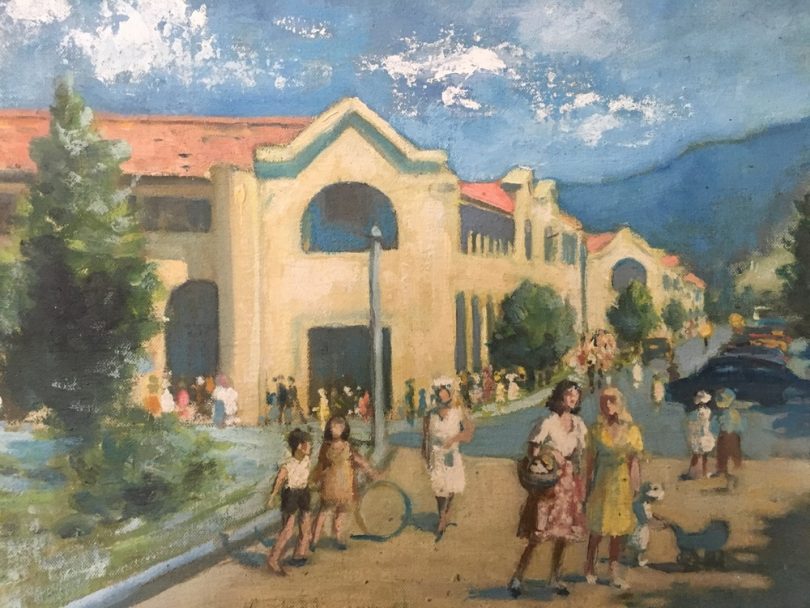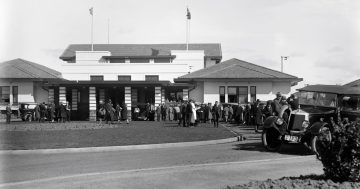
Esther Paterson’s Civic Square Canberra 1947, on loan from Dawn Waterhouse. Image: Supplied.
More than 90 years ago, Dawn Waterhouse came to Canberra as a toddler. Those were the days when a few thousand people lived in the national capital, when you rode a bike to the Cotter for a picnic and sweated your way back, or cantered across the paddocks from Deakin to Woden to take tea with a friend.
Recently, Dawn – who still lives here – spent a wonderful hour at Canberra Museum and Gallery recalling her childhood at Calthorpe’s House and her young adult years.
The event was part of the new Seeing Canberra exhibition at CMAG. While the Museum is currently closed due to COVID-19 restrictions, the exhibition is not scheduled to end until 12 September.
It’s largely drawn from the Museum’s existing collection and describes four key phases in the city’s evolution from its foundations to the present day. Many of the mid-century paintings come from Dawn’s own collection.
After the initial flurry of activity leading up to 1927 with the building and opening of the provisional Parliament House, there were decades of inertia while Canberra remained, essentially, a small country town.
As a child, Dawn recalls walking from Mugga Way to Mt Ainslie and Black Mountain for family picnics along dusty roads depicted in paintings by John Horgan in the exhibition.
“In the 1930s it was rumoured that the city would be abandoned and the public servants returned to Melbourne or Sydney,” Dawn recalled. She pulled out a contemporaneous quote from a visiting journalist describing Canberra as “an unhappy combination of small-town atmosphere, stuffy suburban attitudes and imposed bureaucratic snobbery”.
“We thought that was very very unfair,” Dawn said. “The locals lauded their little paradise and couldn’t understand why others couldn’t see it. Canberra was criticised for so long. All the politicians gave it a very bad name!”
One of the most striking works in the show features Dawn herself – albeit unbeknownst to her at the time it was painted.
Esther Patterson’s painting of Civic Square shows a vibrant busy and sun-filled Civic Square post-war. And at the front, there are two women, one in yellow and one in a red and white skirt, accompanied by a child with a doll’s pram.
They are Dawn, her friend and her daughter Jill, painted on a day Dawn recalls perfectly.
“I’d gone to collect a friend when Jill spotted her friend’s doll pram, said she wanted it and stood her ground. My friend Marj said ‘let her have it’, so off we went with Jill’s new doll in the pram. The skirt was a red and white one [my husband] Doug brought me back from Hawaii.”
Years later Dawn was in Harold White’s house and recognised herself in the painting, to her great surprise. By even greater coincidence, she later found exactly the same work in the Yarralumla brickworks antique shop and bought it.
“There’s a lot of licence in it,” Dawn says. “There were never crowds that size, or a child playing with a hoop – that would have been so old fashioned. There were so many wrong things but it was a happy painting. I never dreamed I would see it again.”
Another Ethel Carrick Fox work shows the colonnade at Civic, a fond recollection for Dawn who watched the buildings go up and confirms that they were originally a rich buttery cream in colour.
Dawn’s father had his real estate business there along with a stock and station agency at Queanbeyan. While the Melbourne Building had banks, post office, solicitors, accountants, architects, dentists, the Sydney side was infinitely more thrilling.
“We had two of everything: chemists greengrocers, butchers, jewellers and clothes, hardware and Verity Hewitt’s wonderful bookshop where she let you just browse. She’d drive a sulky into town and put her baby’s pram in the shop window, so all the little girls would go in to see the baby,” Dawn says.
The Blue Moon cafe was also there, almost the only place in Canberra to buy pies and cakes, a meal and a milkshake or a coffee.
Two Douglas Dundas paintings show views over Acton where the Federal golf course once was with “sand greens, very rough but popular”, and a small landscape of the Deakin anticline – “a volcanic hole, just behind the Deakin shops”, Dawn recalled.
“When I was about 14 I was galloping my horse across the paddock to visit the Edisons at Woden. My horse propped and if I’d gone over the horse’s head I would have been killed!”
Visit CMAG for latest updates due to COVID-19.













